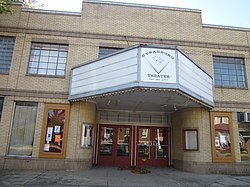Strasburg, Virginia
| Strasburg, Virginia | |||
|---|---|---|---|
| Town | |||

Strasburg Theater
|
|||
|
|||
| Nickname(s): Pot Town | |||
| Location of Strasburg in Virginia | |||
| Coordinates: 38°59′26″N 78°21′31″W / 38.99056°N 78.35861°WCoordinates: 38°59′26″N 78°21′31″W / 38.99056°N 78.35861°W | |||
| Country | United States | ||
| State | Virginia | ||
| County | Shenandoah | ||
| Founded | 1761 | ||
| Incorporated | 1871 | ||
| Founded by | Peter Stover | ||
| Government | |||
| • Type | Mayor-Council | ||
| • Mayor | Rich Orndorff, Jr. | ||
| • Town Manager | Ryan Spitzer | ||
| • Council |
Members' List
|
||
| Area | |||
| • Total | 3.2 sq mi (8.2 km2) | ||
| • Land | 3.2 sq mi (8.2 km2) | ||
| • Water | 0.04 sq mi (0.1 km2) | ||
| Elevation | 578 ft (176 m) | ||
| Population (2010) | |||
| • Total | 6,398 | ||
| Time zone | EST (UTC-5) | ||
| • Summer (DST) | EDT (UTC-4) | ||
| ZIP Code | 22657 | ||
| Area code(s) | 540 | ||
| FIPS code | 51-76000 | ||
| GNIS feature ID | 1487663 | ||
| Website | www |
||
Strasburg /ˈstrɑːzbərɡ/ is a town in Shenandoah County, Virginia, United States, which was founded in 1761 by Peter Stover. It is the largest town by population in the county and is known for its pottery, antiques, and Civil War history. The population was 6,398 at the 2010 census.
German-speaking Pennsylvanians were among the first non-native settlers to arrive in the northern Shenandoah Valley and Strasburg area. The luscious greenery and fertile land were prime targets for immigrant farmers. On August 21, 1734 speculator Henry Willis was granted 2,030 acres (8.2 km2) total of this land by William Gooch, Virginia's Lieutenant Governor and Commander in Chief. Gooch wished to settle the valley to create a buffer between Native American tribes and the rest of the Virginia colony. During the summer of 1735, Willis sold his entire property to Jacob Funk. Jacob in return, partitioned his new purchase, reselling a part of it to his brother John.
In contrast to the English culture found east of the Blue Ridge, Strasburg was settled with family farms and towns rather than plantations; few slaves; and Germanic language, religions, architecture and decorative arts. The thriving agricultural community that developed in the fertile bottomland along the banks of the Shenandoah River boasted scenic views of the Massanutten and Allegheny Mountains. Later nicknamed “Pot Town,” Strasburg also became a center for the production of both utilitarian and fancy earthenware and stoneware pottery. During the 19th and 20th centuries, many residents worked for the railroad industry and at limestone quarries; after WW II, other industries came to Strasburg, including paper and auto parts manufacture. Today Strasburg boasts a growing service economy, museums, charming eateries, numerous antique stores and other shops. Despite its location only 80 miles from Metro D.C. Strasburg has maintained its hospitable small town charm.
...
Wikipedia



